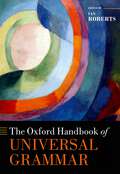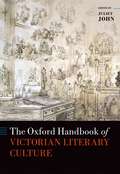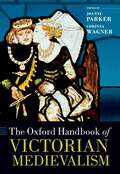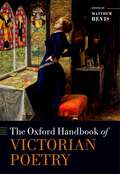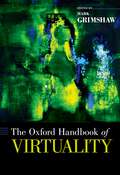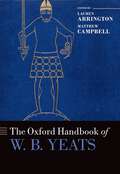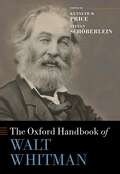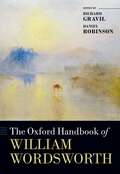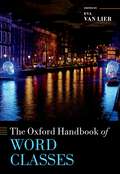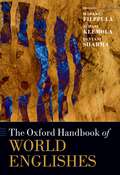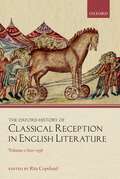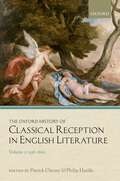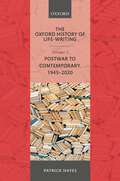- Table View
- List View
The Oxford Handbook of Universal Grammar (Oxford Handbooks)
by Ian RobertsThis handbook provides a critical guide to the most central proposition in modern linguistics: the notion, generally known as Universal Grammar, that a universal set of structural principles underlies the grammatical diversity of the world's languages. Part I considers the implications of Universal Grammar for philosophy of mind and philosophy of language, and examines the history of the theory. Part II focuses on linguistic theory, looking at topics such as explanatory adequacy and how phonology and semantics fit into Universal Grammar. Parts III and IV look respectively at the insights derived from UG-inspired research on language acquisition, and at comparative syntax and language typology, while part V considers the evidence for Universal Grammar in phenomena such as creoles, language pathology, and sign language. The book will be a vital reference for linguists, philosophers, and cognitive scientists.
The Oxford Handbook of Universal Grammar (Oxford Handbooks)
This handbook provides a critical guide to the most central proposition in modern linguistics: the notion, generally known as Universal Grammar, that a universal set of structural principles underlies the grammatical diversity of the world's languages. Part I considers the implications of Universal Grammar for philosophy of mind and philosophy of language, and examines the history of the theory. Part II focuses on linguistic theory, looking at topics such as explanatory adequacy and how phonology and semantics fit into Universal Grammar. Parts III and IV look respectively at the insights derived from UG-inspired research on language acquisition, and at comparative syntax and language typology, while part V considers the evidence for Universal Grammar in phenomena such as creoles, language pathology, and sign language. The book will be a vital reference for linguists, philosophers, and cognitive scientists.
The Oxford Handbook of Victorian Literary Culture (Oxford Handbooks)
by Juliet JohnThe Oxford Handbook of Victorian Literary Culture is a major contribution to the dynamic field of Victorian studies. This collection of 37 original chapters by leading international Victorian scholars offers new approaches to familiar themes including science, religion, and gender, and gives space to newer and emerging topics including old age, fair play, and economics. Structured around three broad sections (Ways of Being: Identity and Ideology, Ways of Understanding: Knowledge and Belief, and Ways of Communicating: Print and Other Cultures), the volume is sub-divided into nine sub-sections each with its own 'lead' essay: on subjectivity, politics, gender and sexuality, place and race, religion, science, material and mass culture, aesthetics and visual culture, and theatrical culture. The collection, like today's Victorian studies, is thoroughly interdisciplinary and yet its substantial Introduction explores a concern which is evident both implicitly and explicitly in the volume's essays: that is, the nature and status of 'literary' culture and the literary from the Victorian period to the present. The diverse and wide-ranging essays present original scholarship framed accessibly for a mixed readership of advanced undergraduates, graduate students, and established scholars.
The Oxford Handbook of Victorian Literary Culture (Oxford Handbooks)
The Oxford Handbook of Victorian Literary Culture is a major contribution to the dynamic field of Victorian studies. This collection of 37 original chapters by leading international Victorian scholars offers new approaches to familiar themes including science, religion, and gender, and gives space to newer and emerging topics including old age, fair play, and economics. Structured around three broad sections (Ways of Being: Identity and Ideology, Ways of Understanding: Knowledge and Belief, and Ways of Communicating: Print and Other Cultures), the volume is sub-divided into nine sub-sections each with its own 'lead' essay: on subjectivity, politics, gender and sexuality, place and race, religion, science, material and mass culture, aesthetics and visual culture, and theatrical culture. The collection, like today's Victorian studies, is thoroughly interdisciplinary and yet its substantial Introduction explores a concern which is evident both implicitly and explicitly in the volume's essays: that is, the nature and status of 'literary' culture and the literary from the Victorian period to the present. The diverse and wide-ranging essays present original scholarship framed accessibly for a mixed readership of advanced undergraduates, graduate students, and established scholars.
The Oxford Handbook of Victorian Medievalism (Oxford Handbooks)
by Joanne Parker Corinna WagnerIn 1859, the historian Lord John Acton asserted: 'two great principles divide the world, and contend for the mastery, antiquity and the middle ages'. The influence on Victorian culture of the 'Middle Ages' (broadly understood then as the centuries between the Roman Empire and the Renaissance) was both pervasive and multi-faceted. This 'medievalism' led, for instance, to the rituals and ornament of the Medieval Catholic church being reintroduced to Anglicanism. It led to the Saxon Witan being celebrated as a prototypical representative parliament. It resulted in Viking raiders being acclaimed as the forefathers of the British navy. And it encouraged innumerable nineteenth-century men to cultivate the superlative beards we now think of as typically 'Victorian'—in an attempt to emulate their Anglo-Saxon forefathers. Different facets of medieval life, and different periods before the Renaissance, were utilized in nineteenth-century Britain for divergent political and cultural agendas. Medievalism also became a dominant mode in Victorian art and architecture, with 75 per cent of churches in England built on a Gothic rather than a classical model. And it was pervasive in a wide variety of literary forms, from translated sagas to pseudo-medieval devotional verse to triple-decker novels. Medievalism even transformed nineteenth-century domesticity: while only a minority added moats and portcullises to their homes, the medieval-style textiles produced by Morris and Co. decorated many affluent drawing rooms. The Oxford Handbook of Victorian Medievalism is the first work to examine in full the fascinating phenomenon of 'medievalism' in Victorian Britain. Covering art, architecture, religion, literature, politics, music, and social reform, the Handbook also surveys earlier forms of antiquarianism that established the groundwork for Victorian movements. In addition, this collection addresses the international context, by mapping the spread of medievalism across Europe, South America, and India, amongst other places.
The Oxford Handbook of Victorian Medievalism (Oxford Handbooks)
In 1859, the historian Lord John Acton asserted: 'two great principles divide the world, and contend for the mastery, antiquity and the middle ages'. The influence on Victorian culture of the 'Middle Ages' (broadly understood then as the centuries between the Roman Empire and the Renaissance) was both pervasive and multi-faceted. This 'medievalism' led, for instance, to the rituals and ornament of the Medieval Catholic church being reintroduced to Anglicanism. It led to the Saxon Witan being celebrated as a prototypical representative parliament. It resulted in Viking raiders being acclaimed as the forefathers of the British navy. And it encouraged innumerable nineteenth-century men to cultivate the superlative beards we now think of as typically 'Victorian'—in an attempt to emulate their Anglo-Saxon forefathers. Different facets of medieval life, and different periods before the Renaissance, were utilized in nineteenth-century Britain for divergent political and cultural agendas. Medievalism also became a dominant mode in Victorian art and architecture, with 75 per cent of churches in England built on a Gothic rather than a classical model. And it was pervasive in a wide variety of literary forms, from translated sagas to pseudo-medieval devotional verse to triple-decker novels. Medievalism even transformed nineteenth-century domesticity: while only a minority added moats and portcullises to their homes, the medieval-style textiles produced by Morris and Co. decorated many affluent drawing rooms. The Oxford Handbook of Victorian Medievalism is the first work to examine in full the fascinating phenomenon of 'medievalism' in Victorian Britain. Covering art, architecture, religion, literature, politics, music, and social reform, the Handbook also surveys earlier forms of antiquarianism that established the groundwork for Victorian movements. In addition, this collection addresses the international context, by mapping the spread of medievalism across Europe, South America, and India, amongst other places.
The Oxford Handbook of Victorian Poetry (Oxford Handbooks)
'I am inclined to think that we want new forms . . . as well as thoughts', confessed Elizabeth Barrett to Robert Browning in 1845. The Oxford Handbook of Victorian Poetry provides a closely-read appreciation of the vibrancy and variety of Victorian poetic forms, and attends to poems as both shaped and shaping forces. The volume is divided into four main sections. The first section on 'Form' looks at a few central innovations and engagements—'Rhythm', 'Beat', 'Address', 'Rhyme', 'Diction', 'Syntax', and 'Story'. The second section, 'Literary Landscapes', examines the traditions and writers (from classical times to the present day) that influence and take their bearings from Victorian poets. The third section provides 'Readings' of twenty-three poets by concentrating on particular poems or collections of poems, offering focused, nuanced engagements with the pleasures and challenges offered by particular styles of thinking and writing. The final section, 'The Place of Poetry', conceives and explores 'place' in a range of ways in order to situate Victorian poetry within broader contexts and discussions: the places in which poems were encountered; the poetic representation and embodiment of various sites and spaces; the location of the 'Victorian' alongside other territories and nationalities; and debates about the place - and displacement - of poetry in Victorian society. This Handbook is designed to be not only an essential resource for those interested in Victorian poetry and poetics, but also a landmark publication—provocative, seminal volume that will offer a lasting contribution to future studies in the area.
The Oxford Handbook of Virginia Woolf (Oxford Handbooks)
by Anne E. FernaldWith thirty-nine original chapters from internationally prominent scholars, The Oxford Handbook of Virginia Woolf is designed for scholars and graduate students. Feminist to the core, each chapter examines an aspect of Woolf's achievement and legacy. Each contribution offers an overview that is at once fresh and thoroughly grounded in prior scholarship. Six sections focus on Woolf's life, her texts, her experiments, her life as a professional, her contexts, and her afterlife. Opening chapters on Woolf's life address the powerful influences of family, friends, and home. The section on her works moves chronologically, emphasizing Woolf's practice of writing essays and reviews alongside her fiction. Chapters on Woolf's experimentalism pay special attention to the literariness of Woolf's writing, with opportunity to trace its distinctive watermark while 'Professions of Writing', invites readers to consider how Woolf worked in cultural fields including and extending beyond the Hogarth Press and the TLS. The 'Contexts' section moves beyond writing to depict her engagement with the natural world as well as the political, artistic, and popular culture of her time. The final section on afterlives demonstrates the many ways Woolf's reputation continues to grow, across the globe, and across media, in ideas and in artistic expression. Of particular note, chapters explore three distinct Woolfian traditions in fiction: the novel of manners, magical realism, and the feminist novel.
The Oxford Handbook of Virginia Woolf (Oxford Handbooks)
With thirty-nine original chapters from internationally prominent scholars, The Oxford Handbook of Virginia Woolf is designed for scholars and graduate students. Feminist to the core, each chapter examines an aspect of Woolf's achievement and legacy. Each contribution offers an overview that is at once fresh and thoroughly grounded in prior scholarship. Six sections focus on Woolf's life, her texts, her experiments, her life as a professional, her contexts, and her afterlife. Opening chapters on Woolf's life address the powerful influences of family, friends, and home. The section on her works moves chronologically, emphasizing Woolf's practice of writing essays and reviews alongside her fiction. Chapters on Woolf's experimentalism pay special attention to the literariness of Woolf's writing, with opportunity to trace its distinctive watermark while 'Professions of Writing', invites readers to consider how Woolf worked in cultural fields including and extending beyond the Hogarth Press and the TLS. The 'Contexts' section moves beyond writing to depict her engagement with the natural world as well as the political, artistic, and popular culture of her time. The final section on afterlives demonstrates the many ways Woolf's reputation continues to grow, across the globe, and across media, in ideas and in artistic expression. Of particular note, chapters explore three distinct Woolfian traditions in fiction: the novel of manners, magical realism, and the feminist novel.
The Oxford Handbook of W.B. Yeats (Oxford Handbooks)
by Lauren Arrington and Matthew CampbellThe forty-two chapters in this book consider Yeats's early toil, his practical and esoteric concerns as his career developed, his friends and enemies, and how he was and is understood. This Handbook brings together critics and writers who have considered what Yeats wrote and how he wrote, moving between texts and their contexts in ways that will lead the reader through Yeats's multiple selves as poet, playwright, public figure, and mystic. It assembles a variety of views and adds to a sense of dialogue, the antinomian or deliberately-divided way of thinking that Yeats relished and encouraged. This volume puts that sense of a living dialogue in tune both with the history of criticism on Yeats and also with contemporary critical and ethical debates, not shirking the complexities of Yeats's more uncomfortable political positions or personal life. It provides one basis from which future Yeats scholarship can continue to participate in the fascination of all the contributors here in the satisfying difficulty of this great writer.
The Oxford Handbook of W.B. Yeats (Oxford Handbooks)
The forty-two chapters in this book consider Yeats's early toil, his practical and esoteric concerns as his career developed, his friends and enemies, and how he was and is understood. This Handbook brings together critics and writers who have considered what Yeats wrote and how he wrote, moving between texts and their contexts in ways that will lead the reader through Yeats's multiple selves as poet, playwright, public figure, and mystic. It assembles a variety of views and adds to a sense of dialogue, the antinomian or deliberately-divided way of thinking that Yeats relished and encouraged. This volume puts that sense of a living dialogue in tune both with the history of criticism on Yeats and also with contemporary critical and ethical debates, not shirking the complexities of Yeats's more uncomfortable political positions or personal life. It provides one basis from which future Yeats scholarship can continue to participate in the fascination of all the contributors here in the satisfying difficulty of this great writer.
The Oxford Handbook of Walt Whitman (Oxford Handbooks)
by Kenneth M. Price Stefan SchöberleinMore than a century after his death, Walt Whitman remains a fresh phenomenon. Startling discoveries and massive transcription efforts are enabling new insights into his life and achievements. In the past few years new breakthroughs have proliferated, including the publication of a long-lost Whitman novel, Jack Engle, along with a hitherto unknown health guide for urban men and previously undiscovered poems. Myriad other documents have become more readily available, including largely unmined troves of journalism, narrative and documentary prose, and experimental note-keeping. Leaves of Grass and Whitman's literary life as a whole are thus ripe for reconsideration. The Oxford Handbook of Walt Whitman embraces this expanded view of Whitman and charts new pathways in Whitman Studies by bringing in new perspectives, methods, and contexts.
The Oxford Handbook of Walt Whitman (Oxford Handbooks)
by Kenneth M. Price Stefan SchöberleinMore than a century after his death, Walt Whitman remains a fresh phenomenon. Startling discoveries and massive transcription efforts are enabling new insights into his life and achievements. In the past few years new breakthroughs have proliferated, including the publication of a long-lost Whitman novel, Jack Engle, along with a hitherto unknown health guide for urban men and previously undiscovered poems. Myriad other documents have become more readily available, including largely unmined troves of journalism, narrative and documentary prose, and experimental note-keeping. Leaves of Grass and Whitman's literary life as a whole are thus ripe for reconsideration. The Oxford Handbook of Walt Whitman embraces this expanded view of Whitman and charts new pathways in Whitman Studies by bringing in new perspectives, methods, and contexts.
The Oxford Handbook of William Wordsworth (Oxford Handbooks)
by Richard Gravil and Daniel RobinsonThe Oxford Handbook of William Wordsworth deploys its forty-seven original essays to present a stimulating account of Wordsworth's life and achievement and to map new directions in criticism. In addition to twenty-two essays wholly on Wordsworth's poetry, other essays return to the poetry while exploring other dimensions of the life and work of the major Romantic poet. The result is a dialogic exploration of many major texts and problems in Wordsworth scholarship. This uniquely comprehensive handbook is structured so as to present, in turn, Wordsworth's life, career, and networks; aspects of the major lyrical and narrative poetry; components of 'The Recluse'; his poetical inheritance and his transformation of poetics; the variety of intellectual influences upon his work, from classical republican thought to modern science; his shaping of modern culture in such fields as gender, landscape, psychology, ethics, politics, religion, and ecology; and his 19th- and 20th-century reception-most importantly by poets, but also in modern criticism and scholarship.
The Oxford Handbook of William Wordsworth (Oxford Handbooks)
The Oxford Handbook of William Wordsworth deploys its forty-seven original essays to present a stimulating account of Wordsworth's life and achievement and to map new directions in criticism. In addition to twenty-two essays wholly on Wordsworth's poetry, other essays return to the poetry while exploring other dimensions of the life and work of the major Romantic poet. The result is a dialogic exploration of many major texts and problems in Wordsworth scholarship. This uniquely comprehensive handbook is structured so as to present, in turn, Wordsworth's life, career, and networks; aspects of the major lyrical and narrative poetry; components of 'The Recluse'; his poetical inheritance and his transformation of poetics; the variety of intellectual influences upon his work, from classical republican thought to modern science; his shaping of modern culture in such fields as gender, landscape, psychology, ethics, politics, religion, and ecology; and his 19th- and 20th-century reception-most importantly by poets, but also in modern criticism and scholarship.
The Oxford Handbook of Word Classes (Oxford Handbooks)
by Eva Van LierThis handbook explores multiple facets of the study of word classes, also known as parts of speech or lexical categories. These categories are of fundamental importance to linguistic theory and description, both formal and functional, and for both language-internal analyses and cross-linguistic comparison. The volume consists of five parts that investigate word classes from different angles. Chapters in the first part address a range of fundamental issues including diversity and unity in word classes around the world, categorization at different levels of structure, the distinction between lexical and functional words, and hybrid categories. Part II examines the treatment of word classes across a wide range of contemporary linguistic theories, such as Cognitive Grammar, Minimalist Syntax, and Lexical Functional Grammar, while the focus of Part III is on individual word classes, from major categories such as verb and noun to minor ones such as adpositions and ideophones. Part IV provides a number of cross-linguistic case studies, exploring word classes in families including Afroasiatic, Sinitic, Mayan, Austronesian, and in sign languages. Chapters in the final part of the book discuss word classes from the perspective of various sub-disciplines of linguistics, ranging from first and second language acquisition to computational and corpus linguistics. Together, the contributions showcase the importance of word classes for the whole discipline of linguistics, while also highlighting the many ongoing debates in the areas and outlining fruitful avenues for future research.
The Oxford Handbook of Word Classes (Oxford Handbooks)
This handbook explores multiple facets of the study of word classes, also known as parts of speech or lexical categories. These categories are of fundamental importance to linguistic theory and description, both formal and functional, and for both language-internal analyses and cross-linguistic comparison. The volume consists of five parts that investigate word classes from different angles. Chapters in the first part address a range of fundamental issues including diversity and unity in word classes around the world, categorization at different levels of structure, the distinction between lexical and functional words, and hybrid categories. Part II examines the treatment of word classes across a wide range of contemporary linguistic theories, such as Cognitive Grammar, Minimalist Syntax, and Lexical Functional Grammar, while the focus of Part III is on individual word classes, from major categories such as verb and noun to minor ones such as adpositions and ideophones. Part IV provides a number of cross-linguistic case studies, exploring word classes in families including Afroasiatic, Sinitic, Mayan, Austronesian, and in sign languages. Chapters in the final part of the book discuss word classes from the perspective of various sub-disciplines of linguistics, ranging from first and second language acquisition to computational and corpus linguistics. Together, the contributions showcase the importance of word classes for the whole discipline of linguistics, while also highlighting the many ongoing debates in the areas and outlining fruitful avenues for future research.
The Oxford Handbook of World Englishes (Oxford Handbooks)
by Markku Filppula, Juhani Klemola and Devyani SharmaAs the most widely documented language in human history, English holds a unique key to unlocking some of the mysteries of the uniquely human endowment of language. Yet the field of World Englishes has remained somewhat marginal in linguistic theory. This collection heralds a more direct and mutually constructive engagement with current linguistic theories, questions, and methodologies. It achieves this through areal overviews, theoretical chapters, and case studies. The 36 articles are divided between four themes: Foundations, World Englishes and Linguistic Theory, Areal Profiles, and Case Studies. Part I sets out the complex history of the global spread of English. This is followed, in Part II, by chapters addressing the mutual relevance and importance of World Englishes and numerous theoretical subfields of Linguistics. Part III offers detailed accounts of the structure and social histories of specific varieties of English spoken across the globe, highlighting points of theoretical interest. The collection closes with a set of case studies that exemplify the type of analysis encouraged by the volume. As attention is focused on innovative work at the interface of dialect description and theoretical explanation, the book is more succinct in its treatment of applied themes, which are given complementary coverage in other works.
The Oxford Handbook of World Englishes (Oxford Handbooks)
As the most widely documented language in human history, English holds a unique key to unlocking some of the mysteries of the uniquely human endowment of language. Yet the field of World Englishes has remained somewhat marginal in linguistic theory. This collection heralds a more direct and mutually constructive engagement with current linguistic theories, questions, and methodologies. It achieves this through areal overviews, theoretical chapters, and case studies. The 36 articles are divided between four themes: Foundations, World Englishes and Linguistic Theory, Areal Profiles, and Case Studies. Part I sets out the complex history of the global spread of English. This is followed, in Part II, by chapters addressing the mutual relevance and importance of World Englishes and numerous theoretical subfields of Linguistics. Part III offers detailed accounts of the structure and social histories of specific varieties of English spoken across the globe, highlighting points of theoretical interest. The collection closes with a set of case studies that exemplify the type of analysis encouraged by the volume. As attention is focused on innovative work at the interface of dialect description and theoretical explanation, the book is more succinct in its treatment of applied themes, which are given complementary coverage in other works.
The Oxford History of Classical Reception in English Literature: Volume 1: 800-1558 (Oxford History of Classical Reception in English Literature)
by Rita CopelandThe Oxford History of Classical Reception in English Literature (OHCREL) is designed to offer a comprehensive investigation of the numerous and diverse ways in which literary texts of the classical world have stimulated responses and refashioning by English writers. Covering the full range of English literature from the early Middle Ages to the present day, OHCREL both synthesizes existing scholarship and presents cutting-edge new research, employing an international team of expert contributors for each of the five volumes. OHCREL endeavours to interrogate, rather than inertly reiterate, conventional assumptions about literary 'periods', the processes of canon-formation, and the relations between literary and non-literary discourse. It conceives of 'reception' as a complex process of dialogic exchange and, rather than offering large cultural generalizations, it engages in close critical analysis of literary texts. It explores in detail the ways in which English writers' engagement with classical literature casts as much light on the classical originals as it does on the English writers' own cultural context. This first volume, and fourth to appear in the series, covers the years c.800-1558, and surveys the reception and transformation of classical literary culture in England from the Anglo-Saxon period up to the Henrician era. Chapters on the classics in the medieval curriculum, the trivium and quadrivium, medieval libraries, and medieval mythography provide context for medieval reception. The reception of specific classical authors and traditions is represented in chapters on Virgil, Ovid, Lucan, Statius, the matter of Troy, Boethius, moral philosophy, historiography, biblical epics, English learning in the twelfth century, and the role of antiquity in medieval alliterative poetry. The medieval section includes coverage of Chaucer, Gower, and Lydgate, while the part of the volume dedicated to the later period explores early English humanism, humanist education, and libraries in the Henrician era, and includes chapters that focus on the classicism of Skelton, Douglas, Wyatt, and Surrey.
The Oxford History of Classical Reception in English Literature: Volume 2: 1558-1660 (Oxford History of Classical Reception in English Literature)
by Philip Hardie Patrick CheneyThe Oxford History of Classical Reception (OHCREL) is designed to offer a comprehensive investigation of the numerous and diverse ways in which literary texts of the classical world have stimulated responses and refashioning by English writers. Covering the full range of English literature from the early Middle Ages to the present day, OHCREL both synthesizes existing scholarship and presents cutting-edge new research, employing an international team of expert contributors for each of the five volumes. OHCREL endeavours to interrogate, rather than inertly reiterate, conventional assumptions about literary 'periods', the processes of canon-formation, and the relations between literary and non-literary discourse. It conceives of 'reception' as a complex process of dialogic exchange and, rather than offering large cultural generalizations, it engages in close critical analysis of literary texts. It explores in detail the ways in which English writers' engagement with classical literature casts as much light on the classical originals as it does on the English writers' own cultural context. This second volume covers the years 1558-1660, and explores the reception of the ancient genres and authors in English Renaissance literature, engaging with the major, and many of the minor, writers of the period, including Shakespeare, Marlowe, Spenser, and Jonson. Separate chapters examine the Renaissance institutions and contexts which shape the reception of antiquity, and an annotated bibliography provides substantial material for further reading.
The Oxford History of Classical Reception in English Literature: Volume 1: 800-1558 (Oxford History of Classical Reception in English Literature)
The Oxford History of Classical Reception in English Literature (OHCREL) is designed to offer a comprehensive investigation of the numerous and diverse ways in which literary texts of the classical world have stimulated responses and refashioning by English writers. Covering the full range of English literature from the early Middle Ages to the present day, OHCREL both synthesizes existing scholarship and presents cutting-edge new research, employing an international team of expert contributors for each of the five volumes. OHCREL endeavours to interrogate, rather than inertly reiterate, conventional assumptions about literary 'periods', the processes of canon-formation, and the relations between literary and non-literary discourse. It conceives of 'reception' as a complex process of dialogic exchange and, rather than offering large cultural generalizations, it engages in close critical analysis of literary texts. It explores in detail the ways in which English writers' engagement with classical literature casts as much light on the classical originals as it does on the English writers' own cultural context. This first volume, and fourth to appear in the series, covers the years c.800-1558, and surveys the reception and transformation of classical literary culture in England from the Anglo-Saxon period up to the Henrician era. Chapters on the classics in the medieval curriculum, the trivium and quadrivium, medieval libraries, and medieval mythography provide context for medieval reception. The reception of specific classical authors and traditions is represented in chapters on Virgil, Ovid, Lucan, Statius, the matter of Troy, Boethius, moral philosophy, historiography, biblical epics, English learning in the twelfth century, and the role of antiquity in medieval alliterative poetry. The medieval section includes coverage of Chaucer, Gower, and Lydgate, while the part of the volume dedicated to the later period explores early English humanism, humanist education, and libraries in the Henrician era, and includes chapters that focus on the classicism of Skelton, Douglas, Wyatt, and Surrey.
The Oxford History of Classical Reception in English Literature: Volume 2: 1558-1660 (Oxford History of Classical Reception in English Literature)
The Oxford History of Classical Reception (OHCREL) is designed to offer a comprehensive investigation of the numerous and diverse ways in which literary texts of the classical world have stimulated responses and refashioning by English writers. Covering the full range of English literature from the early Middle Ages to the present day, OHCREL both synthesizes existing scholarship and presents cutting-edge new research, employing an international team of expert contributors for each of the five volumes. OHCREL endeavours to interrogate, rather than inertly reiterate, conventional assumptions about literary 'periods', the processes of canon-formation, and the relations between literary and non-literary discourse. It conceives of 'reception' as a complex process of dialogic exchange and, rather than offering large cultural generalizations, it engages in close critical analysis of literary texts. It explores in detail the ways in which English writers' engagement with classical literature casts as much light on the classical originals as it does on the English writers' own cultural context. This second volume covers the years 1558-1660, and explores the reception of the ancient genres and authors in English Renaissance literature, engaging with the major, and many of the minor, writers of the period, including Shakespeare, Marlowe, Spenser, and Jonson. Separate chapters examine the Renaissance institutions and contexts which shape the reception of antiquity, and an annotated bibliography provides substantial material for further reading.
The Oxford History of Life-Writing: Volume 7: Postwar to Contemporary, 1945-2020 (Oxford History of Life-Writing)
by Patrick HayesWith the growing urgency of questions about how to claim identity and achieve authenticity, life-writing started to acquire an unprecedented cultural importance. A range of social and economic developments, from the publishing boom in memoir writing to the rise of the internet, transformed the possibilities for self-expression. By the end of the timespan covered in this book life-writing was no longer something done mainly by important individuals who wrote their autobiography, or by sensitive souls who kept a diary. It became a truly ubiquitous phenomenon, part and parcel of the everyday formation of selfhood. Considering a diverse range of texts from across the English-speaking world, this volume places life-writing in relation to wider debates about the sociology and philosophy of modern identity, and the changing marketplace of publishing and bookselling. Yet in doing so it seeks above all to credit the extraordinary literary inventiveness which the pursuit of self-knowledge inspired in this period. Major subjects addressed include: the aftermath of World War II, including responses to the Holocaust; the impact of psychoanalysis on biography; autofiction, autrebiography, and changing ideas about authentic self-knowledge; coming out memoirs and the transformation of sexual identity; feminist exemplary writing and lyric poetry; multilingualism and intercultural life-writing; the memoir boom and the decline of intimacy; testimony narrative and memory culture; posthumanism in theory and practice; literary biography as an alternative to literary theory; literary celebrity and its consequences for literature; social media and digital life-writing.
